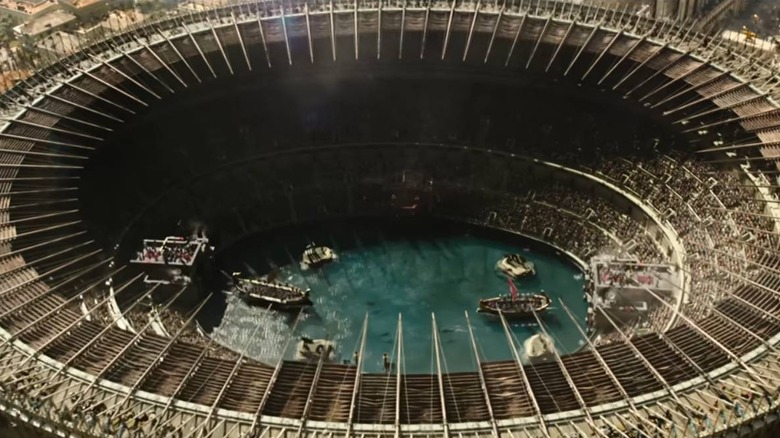Did Gladiator 2's Water Battles Actually Happen In Real Life?
There's a lot to take in from the epic first trailer for "Gladiator 2," and while it looks like an action-packed follow-up, the trailer also has its fair share of detractors for seemingly historical inaccuracies. The one thing everyone hates about the "Gladiator 2" trailer is its song choice, opting for a Jay-Z needle drop that's an anachronistic nightmare. Some people may even raise their eyebrows at a moment where the Colosseum is filled up with water and boats for gladiators to engage in a naval fight. While it seems like a flight of fancy, historians suggest such a thing actually happened in real life.
The Telegraph spoke with Dr. Daisy Dunn, an author and classicist, about the validity of flooding the Colosseum, and, surprisingly, such a thing probably did happen. "There's a specific reference by the historian Cassius Dio to Emperor Titus suddenly filling the Colosseum with water to host a surprise naval battle there," she states. While the logistics of specifically filling the Colosseum with water continue to baffle many who study the era, recreating naval fights in some manner happened throughout Roman history, even before the Colosseum was built.
Such events are referred to as "naumachia," when Ancient Rome celebrated naval battles by recreating them on nearby lakes or flooding areas where water could be easily transported. This not only entailed bringing in vast amounts of water, but also sea creatures like dolphins and sharks so that it could be as accurate as possible. How could you not be entertained?
Naumachia, as seen in Gladiator 2, date back to 46 BC
"Gladiator" and its sequel obviously aren't meant to be 100% historical documents. It's understandable if some creative liberties are taken, but sometimes, truth is stranger than fiction. That holds true when researching the history of naumachia or looking at how gladiator battles did, in fact, involve rhinos and sharks occasionally. According to The Telegraph, the first naumachia recorded was in 46 B.C. from Julius Caesar, who staged a naval reenactment of his quelling of rebellions in Egypt, Pontus, and elsewhere. The bloodshed was excessive, as slaves and prisoners were brought on to risk their lives at the expense of the masses' entertainment.
Naturally, these events weren't cheap, so they weren't held too frequently. And the custom tapered off after one example where an arena was flooded for all of the combatants to do battle. However, things became all the more treacherous when heavy rains killed all the participants. On top of that, many spectators died from the storm or from getting sick in the aftermath. Regular gladiator battles continued, and the addition of underground tunnels beneath the Colosseum prevented any future flooding from taking place.
The timeline for flooding the Colosseum as shown in the trailer is a bit off. "Gladiator 2" takes place roughly around the year 211 A.D., but naumachia was no longer happening at the Colosseum at that time. Still, an epic naval battle is such an awesome idea, it's easy to see why the creatives behind "Gladiator 2" wanted to incorporate it, and it's bound to be a highlight of the film when audiences can finally see it on November 22.
